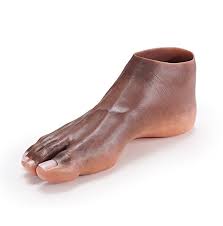SILICON PROSTHESES
Medical-grade silicone is used to create artificial body parts known as silicone prostheses. These prostheses are frequently used to replace or improve body structures in a variety of medical and cosmetic applications.Particularly for external body parts like fingers, hands, feet, ears, noses, and breasts, silicone prostheses are frequently used for both functional and cosmetic restoration. Comfort, style, and functionality all depend on proper fitting and adjustment.
Leg prostheses can assist patients in regaining their mobility and appearance after an amputation. They are flexible and soft, absorbing vibrations to maximize comfort while staying firmly in place. This lessens swelling, eases phantom pain, and shields patients from pain brought on by pressure and friction.
Silicone is used to make prosthetic fingers, and various acrylic color combinations are typically used to create the finger nails. The majority of prosthetic fingers are merely suspended by the suction that is created between the residual finger stump and the prosthesis. All of the air between the silicone and the skin is released when the prosthesis is pushed onto the remaining finger, creating a very stable and secure suspension.
BEST SILICON PROSTHESES | BACK UP LIMBS 9321110091
Types of Silicone Prostheses:
- Limb Prostheses – Used for amputees, providing functional and cosmetic replacement for lost arms, legs, hands, or feet.
- Breast Prostheses – Used after mastectomy or for cosmetic enhancement.
- Facial Prostheses – Replace missing facial structures like noses, ears, or parts of the jaw due to congenital defects, trauma, or surgery.
- Finger and Toe Prostheses – Custom-made replacements for missing digits.
- Buttock and Calf Prostheses – Used for aesthetic enhancement.
- Maxillofacial Prostheses – Used in dentistry and reconstructive surgery for patients with missing facial structures due to cancer or injury.
Advantages of Silicone Prostheses:
- Natural Look and Feel – Mimics the appearance and texture of real skin.
- Durable and Flexible – Resistant to wear and tear.
- Customizable – Can be color-matched and shaped to fit individual needs.
- Biocompatible – Safe for long-term use in the human body.
Why Choose Silicon Prostheses

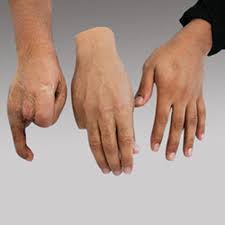

1. Natural Appearance
- Silicone closely mimics the texture and feel of human skin.
- Can be custom-colored to match skin tone.
- Offers a realistic look, making it ideal for cosmetic prosthetics.
2. Comfort and Flexibility
- Soft and flexible, allowing for a comfortable fit.
- Adapts well to body movements.
- Reduces irritation compared to harder materials.
3. Durability and Longevity
- Resistant to wear and tear.
- Can withstand exposure to water, heat, and daily activities.
- Requires minimal maintenance.
4. Customization
- Can be tailored to individual needs and preferences.
- Available in various shapes and sizes.
- Allows for intricate detailing, such as veins, freckles, and nails.
5. Hypoallergenic and Skin-Friendly
- Non-toxic and safe for long-term use.
- Reduces risk of allergic reactions.
- Breathable and comfortable for sensitive skin.
6. Versatility
- Suitable for different types of prostheses, including breast, limb, and facial prosthetics.
- Works well for both cosmetic and functional applications.
How Silicon Prostheses Improve Quality of Life
1. Restoring Functionality
Silicone prostheses, especially for limbs, restore movement and functionality. They allow users to perform daily tasks, such as walking, gripping objects, or even engaging in recreational activities.
2. Boosting Confidence and Self-Esteem
For those who have lost a body part due to injury, illness, or congenital conditions, silicone prostheses provide a natural appearance. Custom-made prosthetics match skin tone, texture, and features, helping individuals feel more confident in social settings.
3. Enhancing Comfort and Fit
Unlike traditional prosthetics, silicone-based designs offer a softer, more flexible fit, reducing irritation and pressure points. This ensures a more comfortable experience, even with prolonged use.
4. Protection and Support
Silicone prostheses provide cushioning, preventing skin breakdown and protecting sensitive areas. For example, silicone liners in prosthetic limbs help distribute pressure evenly, reducing the risk of sores or discomfort.
5. Improved Mobility and Independence
High-quality silicone prostheses allow individuals to move naturally and regain independence. Whether for daily activities or sports, these prosthetics help users maintain an active lifestyle.
6. Durability and Easy Maintenance
Silicone is resistant to water, heat, and everyday wear, making it a durable choice for long-term use. It’s also easy to clean and maintain, ensuring hygiene and longevity.
7. Psychological Well-being
By restoring both appearance and function, silicone prostheses help individuals overcome the emotional impact of limb loss. This contributes to better mental health, reducing anxiety and depression.
Silicon Prostheses Fittings and Adjustments
1. Prepare Your Skin
- Ensure the area where you’ll place the prosthesis is clean and dry.
- Avoid using lotions or powders, as they can affect adhesion.
- If necessary, apply a skin-safe adhesive or barrier wipes for better grip.
2. Inspect the Prosthesis
- Check for any damage before wearing it.
- Make sure it is clean and free of dust or debris.
3. Positioning the Prosthesis
- For breast prostheses: Insert it into a specially designed mastectomy bra or use adhesive if it’s self-adhering.
- For limb prostheses:
- Put on a liner or sleeve (if required).
- Slide the prosthesis into place, ensuring a snug fit.
- If using a suction or vacuum system, follow the specific instructions provided by your prosthetist.
4. Secure the Prosthesis
- If it uses straps or harnesses, adjust them for comfort and stability.
- For adhesive types, press firmly to attach and smooth out any air pockets.
5. Check for Comfort and Fit
- Walk around or move gently to see if adjustments are needed.
- It should feel secure but not too tight.
6. Removal and Care
- Gently remove it according to the instructions for your specific prosthesis.
- Clean it regularly with mild soap and water, then air dry.
- Store it in a protective case when not in use.

Prosthetics
Prosthetics refers to the design, creation, and use of artificial limbs or body parts to restore mobility and functionality for individuals who have lost a limb due to injury, disease, or congenital conditions. Modern prosthetic devices are made using advanced materials like carbon fiber, silicone, and titanium, ensuring durability, flexibility, and a natural appearance. Technological advancements, such as bionic prosthetics and 3D printing, have significantly improved their functionality, allowing for better movement and comfort. These devices not only enhance physical capabilities but also improve the overall quality of life by restoring independence and confidence.
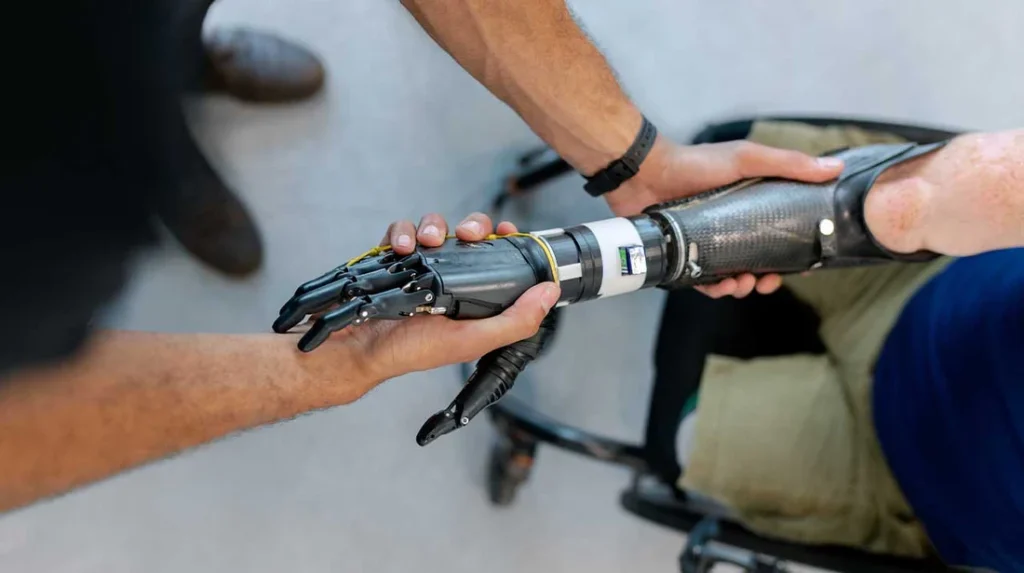
Upper Extremity
The upper extremity refers to the region of the human body that includes the shoulder, arm, forearm, wrist, and hand. It plays a crucial role in performing various daily activities, from lifting and carrying objects to fine motor tasks like writing and typing. The upper extremity consists of bones such as the humerus, radius, and ulna, along with muscles, joints, tendons, and nerves that enable movement and dexterity. Injuries or conditions affecting the upper extremity, such as fractures, arthritis, or nerve damage, can significantly impact mobility and functionality. Medical interventions, including physical therapy, surgery, and prosthetics, help restore strength and movement in cases of impairment.

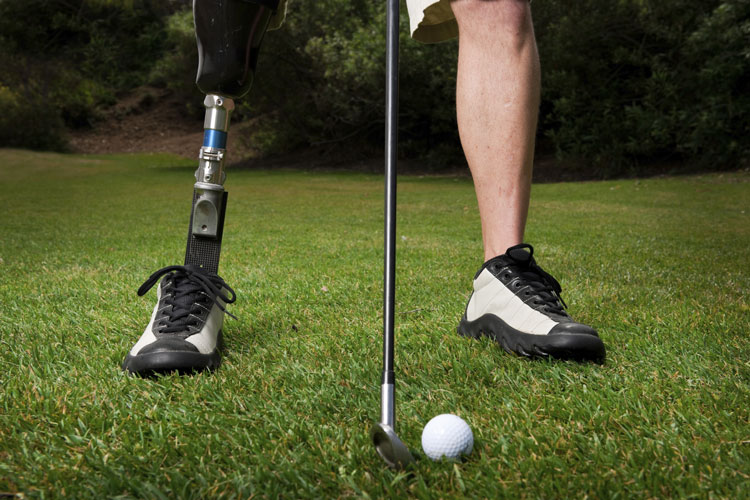
Lower Extremity
The lower extremity refers to the part of the human body that includes the hip, thigh, knee, leg, ankle, and foot. It is essential for weight-bearing, balance, and movement, enabling activities like walking, running, and jumping. The lower extremity consists of major bones such as the femur, tibia, and fibula, along with muscles, ligaments, tendons, and joints that provide strength and flexibility. Injuries or conditions affecting the lower extremity, such as fractures, arthritis, or nerve damage, can severely impact mobility and quality of life. Medical treatments, including physical therapy, surgery, and prosthetics, help restore function and improve movement in cases of impairment.

Silicon Prosthesis
Silicone prosthesis is a type of custom-made artificial body part designed to replace missing limbs, fingers, toes, or facial features with a lifelike appearance and texture. Made from medical-grade silicone, these prosthetics closely mimic natural skin in color, texture, and flexibility, providing both functional and aesthetic benefits. They are commonly used in cases of amputations, congenital deformities, or trauma-related injuries. Silicone prostheses offer comfort, durability, and water resistance, allowing users to carry out daily activities with ease. Advanced techniques, such as color matching and embedded details like veins and fingerprints, enhance realism, boosting the confidence and quality of life of individuals who use them.

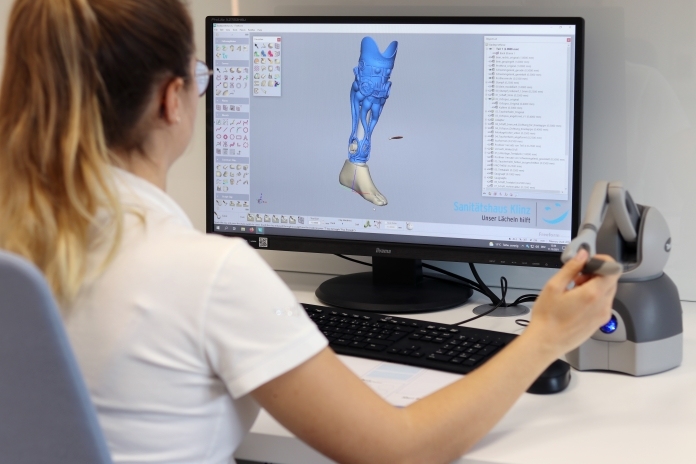
3D Scanning Prosthesis
3D scanning prosthesis is an advanced technology that uses high-precision 3D scanning to create customized prosthetic limbs and body parts with exceptional accuracy. This process captures detailed measurements of the residual limb or affected area, ensuring a perfect fit and enhanced comfort for the user. By eliminating traditional molding techniques, 3D scanning significantly reduces the time required for prosthesis fabrication while improving precision and design efficiency. Combined with 3D printing, this technology allows for lightweight, durable, and highly functional prosthetics tailored to individual needs. It has revolutionized the field of prosthetics by making high-quality, affordable, and personalized solutions more accessible to amputees and individuals with limb differences.

Orthotics
Orthotic prosthesis refers to a specialized medical device that combines elements of both orthotics and prosthetics to support, correct, or replace a missing or impaired limb. Orthotic devices, such as braces and supports, help stabilize and improve the function of weakened or deformed limbs, while prosthetic components replace lost body parts to restore mobility. This hybrid approach is particularly beneficial for individuals with conditions like partial amputations, neuromuscular disorders, or joint instability. Advanced materials like carbon fiber, silicone, and 3D-printed components enhance durability, comfort, and functionality. Orthotic prostheses improve mobility, reduce pain, and enhance the overall quality of life by providing tailored support and movement assistance.


Accolades
Accolades prosthesis refers to high-quality, innovative prosthetic solutions that have been recognized for their excellence in design, functionality, and user comfort. These prosthetic devices are developed using cutting-edge technologies, such as 3D printing, advanced biomechanics, and bionic enhancements, to provide superior mobility and adaptability. Many accolade-winning prostheses focus on improving the lives of amputees by offering lightweight, durable, and highly customized designs that closely mimic natural limb movement. Recognized by medical professionals and industry experts, these prosthetic advancements contribute significantly to rehabilitation, independence, and confidence for users, setting new standards in prosthetic care and technology.

Podiascan
Podiascan prosthesis is an advanced prosthetic solution that utilizes podiascan technology to assess foot pressure distribution and gait patterns for individuals with lower limb impairments. This technique involves scanning the foot to analyze weight distribution, arch structure, and pressure points, ensuring a highly customized prosthetic design for optimal comfort and functionality. By using podiascan data, prosthetists can create well-fitted prosthetic feet or orthotic supports that enhance mobility, reduce strain, and prevent complications such as pressure sores or misalignment. This technology is particularly beneficial for individuals with diabetes, limb loss, or orthopedic conditions, as it helps improve balance, posture, and overall movement efficiency.











